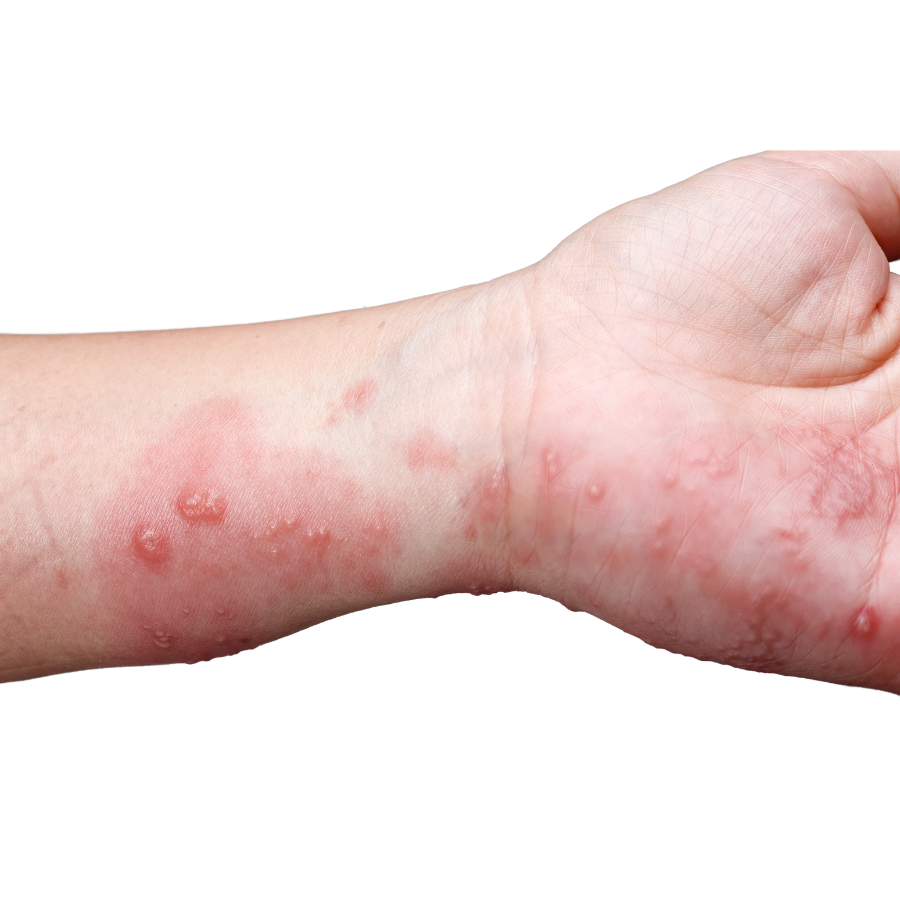Medical Service
Skin Rash
Rashes are so common that they’re virtually unavoidable. It’s extremely common for your skin to itch, develop red patches, or appear bumpy.
Where do rashes come from?
Just because rashes are common, doesn’t mean they should be ignored. A rash could be related to another medical condition.
Skin rashes are usually caused by dermatitis, which is when your skin reacts to an irritant, virus, or allergen. They can occur in one spot, or all over your body. A skin rash could be a temporary condition, or it could affect your entire life. In that case, a dermatologist can craft a treatment plan for your symptoms.
Everyone from infants to older adults can develop rashes. In infants, diaper rash is common. In adults, a rash could also be related to a condition like eczema, hives, and psoriasis. Our board-certified dermatologists offer treatments for psoriasis and eczema.
What are the most common types of rashes?

There are many possible causes of a rash. It could be a reaction to one of the numerous things that the human body comes into contact with daily, including bacteria, viruses, allergens, environmental factors, or even pharmaceutical drugs.
Contact dermatitis occurs when the skin is exposed to an irritant or allergen like poison ivy, latex rubber, or nickel.
Heat rash, or miliaria, appears when the flow of sweat from pores is blocked. This most often occurs when someone overdresses for the heat.
Intertrigo is the result of skin-to-skin friction in areas of the body that are warm and moist, including the groin, between folds of skin on the abdomen, under the breasts, under the arms, or between the toes.
Ringworm of the body is a fungal infection that produces a skin rash.
Shingles is a painful rash that is a result of the varicella-zoster virus, which also causes chicken pox.
Hives appear as a rash after an allergic reaction to airborne allergens, insect stings, bacterial infections, or extreme temperature changes.
What does a rash look like?
When you develop a rash, your skin can appear red, inflamed, bumpy as well as dry, and it can feel itchy or painful. Some rashes even appear as blotches, welts, or blisters. The way a rash looks differs depending on what causes it, as each type creates a different reaction in the skin.
Contact dermatitis usually appears dry, scaly, and itchy.
A heat rash produces clusters of small bumps. Depending on the type of miliaria, the bumps can range in color from red to gray.
Ringworm creates an itchy, circular rash that grows outwards as it spreads, sometimes causing multiple circles to overlap.
An outbreak of shingles begins with pain, then clusters of fluid-filled blisters form over the next few days. The blisters will break open and crust over, and then the crust falls off.
Hives appears as raised, red itchy skin welts.
How are rashes diagnosed?
If your rash is severe or is affecting your daily life, book an appointment with our dermatologists to diagnose its cause and treat it. To diagnose a bacteria or virus rash, your doctor may perform a biopsy. If you suspect you have a rash from an allergic reaction, they will perform allergy tests. Patch testing is used for the diagnosis of allergic contact dermatitis. Learn more about our patch allergy testing here.
How do you treat a rash?
Many rashes can be treated with a medicated cream, or oral antibiotics if it’s a rash from an infection. Contact dermatitis can often be treated with medicated cream to ease the discomfort of your symptoms. Since ringworm is a fungal infection, a topical antifungal medication will clear the rash. If a rash is a reaction to the environment, like hot weather, sweat, wet clothing, or skin friction, remove the irritant by regulating your temperature or changing your clothes. On top of changing your environment, applying an ointment such as Vaseline can help.
Office
3911 Castlevale Rd, Suite 301
Yakima, Washington 98902
Phone
(509) 966 7899
Monday – Thursday:
7:45am – 12:30pm and
1:30p – 5:45p
